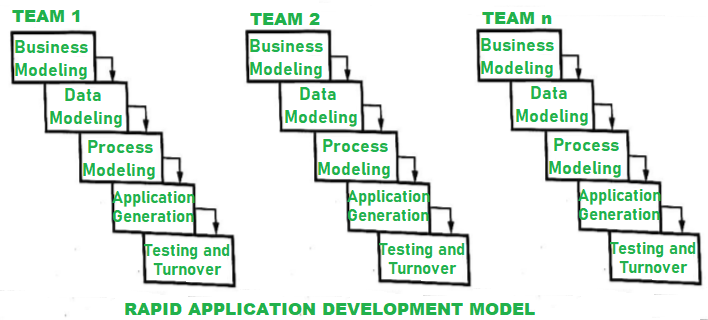Various Phases of RAD Model
Last Updated :
10 Aug, 2020
Rapid Application Development (RAD) model is type of incremental software process model in which components are established or developed in parallel.
RAD is responsible for reusability of component and parallel development of software. Due to this, the time required for development of software is reduced and results in rapid development of software which will cause fast delivery of the product to end-users. In this model, development cycle of project is very short and small.
In the 1980s, Rapid Application Development Model was firstly presented by IBM. The development of this model done with very high and fast speed using construction that is based on components in comparison with Waterfall model. Before using this model, it is very necessary and important to understand requirements of project to fully satisfy the user’s needs completely and to have project scope with restrictions in order to develop system with complete functions without any error or defect within given period of time.

Various phases of the RAD model are:
- Business Modeling –
In business modeling, identification of flow of information is done and is been modeled between different functions of the business. It simply describes how your business will result in payable check that means to make money and explains how you will add value or increase quality of product and deliver valued product to customers at an appropriate cost.
The following information is collected by business functions:
- Information that drives business process that means information gathered during development and before development required for increasing quality so as to develop successful business.
- Type of information being generated during modeling about overall development result so that if there is any change or modification required, it can be done to increase quality.
- Generator of information who generates or makes information.
- Flow of information or direction of flow about how information is transferring so that if there is an issue, it can be resolved.
- Processor of the information who processes identified information and makes changes if required.
- Data Modeling –
In this phase, information collected in business model is classified on basis of different categories and used to define data objects that are available. The characteristics of all data objects that are present are identified that are useful in development of business. Between different data objects, relationship is present that connects them which is defined or explained in this type of modeling.
- Process Modeling –
In this phase, data objects that are necessary are transformed or converted into required usable information or processes. These processes are very important as they help to extract or gain information from data objects so as to make any change required for proper processing without any issue and are responsible for implementing business functions. During this stage, changes and optimization in project development can be done as per requirement to increase value and quality.
- Application Generation –
For creating or developing software, different automation tools can be used. To have an increase in development of software very fastly to reduce development time, RAD makes use of components that are reusable or develops reusable components if not available.
- Testing and Turnover –
RAD uses reusable components so that efforts that are required for testing are reduced. But during software development, if new components are added in process during testing, then testing such new added components is must and essential so that if any error found it can be removed. The testing of all interfaces is equally important to be on safe side of project development without any error.
In RAD Model, it is necessary to understand requirements completely to develop or establish fully functional system. Using reusable components, application development can be done. RAD makes use of reusable components if they are available but if they are less or not available then it makes or creates the required component using automated tools.
RAD Model reduces the time required for development, increases reusability of components, uses feedback from customers to increase quality of product, is very flexible, adapts changes and technologies suggested by customers, and other authorities for an increase in development, has fewer defects due to its prototyping nature. But it has some disadvantages also like it requires large number of people to work on projects, it requires highly committed, loyal developers and customers towards there work, project using RAD model requires heavy and large number of resources so production cost will be high, if there is no appropriate modularization that is modifying program or changing code then RAD project fails, project using RAD model find it very difficult to adopt new technologies and changes.
Like Article
Suggest improvement
Share your thoughts in the comments
Please Login to comment...